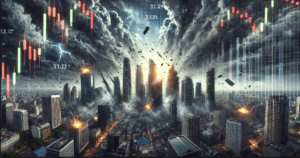Robert Kiyosaki Predicts the Biggest Market Crash in History – Should You Be Worried?
Robert Kiyosaki, author of Rich Dad, Poor Dad, warns of an impending market crash, possibly the biggest in history. He attributes this to economic mismanagement in major economies like the U.S., Germany, and Japan. Ongoing trade tensions, particularly U.S. tariffs on imports, are fueling uncertainty and market instability. The U.S. has already lost $4 trillion in shareholder wealth. While predicting crashes is difficult, history shows that strong companies tend to recover and thrive. Market downturns often create great buying opportunities for long-term investors.
Weak companies may struggle, but financially stable ones could emerge stronger. Instead of panicking, investors should focus on high-quality stocks at attractive valuations. Short-term volatility is inevitable, but disciplined investing leads to long-term gains. Staying patient and keeping cash reserves can help navigate uncertainty. If history repeats, today’s crisis could turn into tomorrow’s best investment opportunity.

Robert Kiyosaki Predicts the Biggest Market Crash in History – Should You Be Worried?
When the name Robert Kiyosaki surfaces, many immediately recall his groundbreaking book, Rich Dad, Poor Dad. My introduction to his work occurred serendipitously at a bustling Mumbai street vendor’s stall during my early days in the city. Though the book didn’t revolutionize my worldview overnight, its core principles—prioritizing asset accumulation, entrepreneurial ventures, and strategic wealth-building—resonated deeply. Kiyosaki’s emphasis on financial literacy and challenging conventional wisdom about money planted seeds of curiosity that grew over time.
Now, years later, his voice has reemerged—not through a new bestseller, but through a stark warning: a potential economic collapse that could eclipse even the Great Depression.
Kiyosaki’s Dire Forecast: “The Everything Bubble”
Recently, Kiyosaki took to social media to sound the alarm about what he dubs “The Everything Bubble”, a crisis he believes could dwarf the 1929 stock market crash. He attributes this looming catastrophe to systemic failures in leadership and fiscal policy within major economies like the U.S., Germany, and Japan. According to him, decades of reckless spending, unchecked debt accumulation, and short-sighted decision-making have inflated asset prices—from real estate to equities—to unsustainable levels. While his apocalyptic tone may seem sensational, it is rooted in genuine concern over rising inflation, ballooning national debts, and geopolitical instability. However, predicting the precise timing or scale of such a collapse remains speculative, as markets are influenced by countless unpredictable variables.
The Tangled Web of Global Economic Tensions
Adding fuel to the fire are escalating trade conflicts and geopolitical rivalries. The ripple effects of policies from the Trump era, such as aggressive tariffs on imports from China, India, and Mexico, continue to destabilize global supply chains. Trump’s “America First” approach aimed to revive domestic manufacturing but inadvertently triggered retaliatory measures, sparking a trade war that strained international relations. For instance, China’s counter-tariffs on U.S. agricultural goods crippled farmers, while Mexico’s levies on American steel disrupted the construction sector.
These protectionist moves, coupled with pandemic-induced disruptions, have created a perfect storm of inflation and scarcity. The U.S. Federal Reserve’s response—raising interest rates to curb inflation—has further complicated matters, increasing borrowing costs for businesses and consumers alike. The result? A staggering $4 trillion erosion in U.S. market value and growing global economic anxiety.
Historical Precedents: Crisis as a Catalyst for Opportunity
While Kiyosaki’s warnings paint a grim picture, history offers a counter-narrative of resilience. Consider the 2008 financial crisis: though devastating, it paved the way for unprecedented innovation in tech and renewable energy. Companies like Amazon and Tesla not only survived but thrived, leveraging the downturn to expand their market share. Similarly, the dot-com bust of the early 2000s weeded out unsustainable startups, allowing robust firms like Google and Apple to emerge stronger. These examples underscore a critical truth: market corrections, while painful, often reset valuations and create opportunities for disciplined investors.
For those with a long-term horizon, downturns can be a goldmine. High-quality stocks—think companies with low debt, strong cash flows, and competitive moats—often become undervalued during panic sell-offs. The key lies in distinguishing between fleeting casualties and resilient enterprises. For instance, during the 2020 pandemic crash, businesses adapted to remote work, and e-commerce boomed, rewarding investors who recognized these trends.
Strategic Investing in Uncertain Times
The current climate demands a balanced approach. While Kiyosaki advocates for alternative assets like gold, silver, and Bitcoin as hedges against inflation, traditional equity markets still hold promise. Diversification across sectors and geographies can mitigate risk, as can dollar-cost averaging, which smooths out volatility over time. Maintaining liquidity is equally crucial; having cash reserves allows investors to capitalize on sudden dips without liquidating existing positions at a loss.
Moreover, psychological resilience is paramount. Fear-driven decisions—such as selling during a downturn—often lock in losses. Warren Buffett’s adage, “Be fearful when others are greedy, and greedy when others are fearful,” encapsulates this mindset. By focusing on fundamentals rather than headlines, investors can avoid the herd mentality that exacerbates market swings.
Conclusion: Navigating the Storm with Foresight
Whether Kiyosaki’s prophecy materializes remains uncertain, but preparedness is non-negotiable. Economic cycles are inevitable, and while downturns test resolve, they also reward patience and strategic thinking. Rather than fixating on doomsday scenarios, investors should refine their portfolios: prioritize companies with sustainable growth models, monitor macroeconomic indicators, and stay informed about policy shifts.
In the end, the difference between crisis and opportunity lies in perspective. The 1929 crash birthed regulatory reforms that stabilized markets for decades. The 2008 meltdown accelerated technological advancements. Today’s challenges may similarly catalyze innovations in AI, green energy, or healthcare. By adhering to disciplined investing principles—sticking to a plan, avoiding leverage, and focusing on quality—the next market crash could transform from a threat into a launchpad for future prosperity.
You must be logged in to post a comment.